Land Use Change and Landscape Ecological Risk Assessment Based on Terrain Gradients in Yuanmou Basin
Abstract
:1. Introduction
2. Materials and Methods
2.1. Study Area
2.2. Data Source
2.3. Research Methods
2.3.1. Land Use Classification Methods
2.3.2. Land Use Transfer Matrix
2.3.3. Landscape Ecological Risk (LER) Analysis
Division of LER
Landscape Ecological Risk Index Construction
2.3.4. Spatial Autocorrelation Analysis
2.3.5. Terrain Gradient Analysis
Terrain Niche Index
Terrain Distribution Index
3. Results
3.1. Analysis of Land Use Change
3.2. Landscape Ecological Risk Analysis
3.3. Spatial Autocorrelation Analysis of Ecological Risk in the Landscape
3.4. The Impact of Topography on Ecological Risk
3.4.1. Landscape Ecological Risk Characterization Based on Elevation Categories
3.4.2. Distribution of Ecological Risk Levels under different Terrain Distribution Indices
4. Discussion
4.1. Landscape Ecological Risks in Response to Land Use Change
4.2. Influence of Terrain Gradients on the Distribution of Ecological Risks
4.3. Enlightenment and Limitation
5. Conclusions
Author Contributions
Funding
Data Availability Statement
Conflicts of Interest
References
- Cheng, Y.; Song, W.; Yu, H.; Wei, X.; Sheng, S.; Liu, B.; Gao, H.; Li, J.; Cao, C.; Yang, D. Assessment and Prediction of Landscape Ecological Risk from Land Use Change in Xinjiang, China. Land 2023, 12, 895. [Google Scholar] [CrossRef]
- Gao, H.; Song, W. Assessing the Landscape Ecological Risks of Land-Use Change. Int. J. Environ. Res. Public Health 2022, 19, 13945. [Google Scholar] [CrossRef] [PubMed]
- Cao, C.; Song, W. Progress and prospect of ecological risks of land use change. Front. Environ. Sci. 2022, 10, 2392. [Google Scholar] [CrossRef]
- Qiu, M.; Zuo, Q.; Wu, Q.; Yang, Z.; Zhang, J. Water ecological security assessment and spatial autocorrelation analysis of prefectural regions involved in the Yellow River Basin. Sci. Rep. 2022, 12, 5105. [Google Scholar] [CrossRef] [PubMed]
- Wang, F.C.; Wang, D.C.; Zhang, L.H.; Liu, J.; Hu, B.; Sun, Z.; Chen, J. Spatiotemporal analysis of the dynamic changes in land use ecological risks in the urban agglomeration of Beijing-Tianjin-Hebei vegion. Acta Ecol. Sin. 2018, 38, 4307–4316. [Google Scholar]
- He, S.; Li, X.; He, C.; Fang, B. Landscape Ecological Risk Assessment in Guangling District of Yangzhou City Based on Land Use Change. J. Nanjing Norm. Univ. (Nat. Sci. Ed.) 2019, 42, 139–148. [Google Scholar]
- Lin, X.; Wang, Z. Landscape ecological risk assessment and its driving factors of multi-mountainous city. Ecol. Indic. 2023, 146, 109823. [Google Scholar] [CrossRef]
- Liu, H.; Hao, H.; Sun, L.; Zhou, T. Spatial–Temporal Evolution Characteristics of Landscape Ecological Risk in the Agro-Pastoral Region in Western China: A Case Study of Ningxia Hui Autonomous Region. Land 2022, 11, 1829. [Google Scholar] [CrossRef]
- Calow, P. Ecological risk assessment: Risk for what? How do we decide? Ecotoxicol. Environ. Saf. 1998, 40, 15–18. [Google Scholar] [CrossRef]
- Rodier, D.; Norton, S. Framework for Ecological Risk Assessment; Environmental Protection Agency: Washington, DC, USA, 1992. [Google Scholar]
- Wang, Y.; Liu, Y.; Zhao, H.; Wu, G.Y.; Yang, Y.; Zhang, F. Water Quality Assessment and Characteristics of Water Pollution of Sand Lake in Ningxia. Wetl. Sci. 2020, 18, 362–367. [Google Scholar] [CrossRef]
- Han, S.; Wang, C.; Liu, X.; Yu, Y.; Xu, M.; Shang, Q. On Distribution Characteristics and Pollution Evaluation of Soil Heavy in Rice Producing Areas of Lianyungang. J. Southwest China Norm. Univ. Nat. Sci. Ed. 2021, 46, 74–78. [Google Scholar] [CrossRef]
- Jia, J.; Liu, X.; Zhao, Y.R. Zeying. Spatial distribution characteristics and assessment of heavy metal pollution in farmland soils in the lower reaches of Fenhe river basin. J. Arid. Land Resour. Environ. 2021, 35, 132–137. [Google Scholar] [CrossRef]
- Gong, J.; Zhao, C.; Xie, Y.; Gao, Y. Ecological risk assessment and its management of Bailongjiang watershed, southern Gansu based on landscape pattern. Yingyong Shengtai Xuebao 2014, 25, 2041–2048. [Google Scholar] [PubMed]
- Wu, J.; Zhu, Q.; Qiao, N.; Wang, Z.; Sha, W.; Luo, K.; Wang, H.; Feng, Z. Ecological risk assessment of coal mine area based on “source-sink” landscape theory—A case study of Pingshuo mining area. J. Clean. Prod. 2021, 295, 126371. [Google Scholar] [CrossRef]
- Zhang, W.; Chang, W.J.; Zhu, Z.C.; Hui, Z. Landscape ecological risk assessment of Chinese coastal cities based on land use change. Appl. Geogr. 2020, 117, 102174. [Google Scholar] [CrossRef]
- Zhang, X.; Yao, L.; Luo, J.; Liang, W. Exploring Changes in Land Use and Landscape Ecological Risk in Key Regions of the Belt and Road Initiative Countries. Land 2022, 11, 940. [Google Scholar] [CrossRef]
- Jing, P.; Zhang, D.; Ai, Z.; Guo, B. Natural landscape ecological risk assessment based on the three-dimensional framework of pattern-process ecological adaptability cycle:a case in Loess Plateau. Acta Ecol. Sin. 2021, 41, 7026–7036. [Google Scholar]
- Fu, W.; Lu, Y.-H.; Fu, B.-J.; Hu, W.-Y. Landscape Ecological Risk Assessment Under the lnfluence of Typical Human Activities in Loess Plateau, Northern Shaanxi. J. Ecol. Rural. Environ. 2019, 35, 290–299. [Google Scholar] [CrossRef]
- Cui, L.; Zhao, Y.; Liu, J.; Han, L.; Ao, Y.; Yin, S. Landscape ecological risk assessment in Qinling Mountain. Geol. J. 2018, 53, 342–351. [Google Scholar] [CrossRef]
- Zhang, X.; Shi, P.; Luo, J. Landscape ecological risk assessment of the Shiyang River basin. In Proceedings of the Geo-Informatics in Resource Management and Sustainable Ecosystem: International Symposium, GRMSE 2013, Wuhan, China, 8–10 November 2013; Proceedings, Part II 1. pp. 98–106. [Google Scholar]
- Sui, X.; Wang, K.; Zheng, S.; An, S.; Li, L. Effects of landscape fragmentation on genetic diversity of Stipa krylovii roshev (Stipa L.) in agro-pastoral ecotone in Northern China. Afr. J. Biotechnol. 2009, 8, 3431–3439. [Google Scholar]
- Song, G.; Wang, P.; Wang, Y. Land-Use Types Change Characteristics and Spatial Heterogeneity in Bayan of Heilongjiang Province. Econ. Geogr. 2015, 35, 163–170. [Google Scholar] [CrossRef]
- Zheng, K.; Li, C.; Wu, Y.; Gao, B.; Li, C.; Wu, Y. Temporal and spatial variation of landscape ecological risk and influential factors in Yunnan border mountainous area. Acta Ecol. Sin. 2022, 42, 7458–7469. [Google Scholar]
- Lin, G.; Cai, H.; Kang, W.; Wu, Y.; Wang, Y. The study on dynamic change of the hillsides landscape feature in the middle and upper reaches of Chishui River. Ecol. Sci. 2019, 38, 151–159. [Google Scholar] [CrossRef]
- Yan, Y.; Yang, L.; Wang, W.; Fang, H.; Zhuang, Q. Analysis of spatial-temporal variation of landscape ecological risk and its terrain gradient in lli valley. Ecol. Sci. 2020, 39, 125–136. [Google Scholar] [CrossRef]
- Hu, J.L.; Zhou, Z.X.; Teng, M.; Luo, N. Ecological risk assessment of typical karst basin based on land use change:A case study of Lijiang River basin, Southern China. Chin. J. Appl. Ecol. 2017, 28, 2003–2012. [Google Scholar] [CrossRef]
- Liu, D.; Chen, H.; Zhang, M.; Shang, S.; Liang, X. Analysis of Spatial-temporal Distribution of Landscape Ecological Risk in EcologicallyVulnerable Areas and lts Terrain Gradient—A Case Study of Mizhi County of Shaanxi Province. Res. Soil Water Conserv. 2019, 26, 239–244+251. [Google Scholar] [CrossRef]
- Ming, Q.; Shi, Z. New Discussion on Dry Valley Formation in the Three Parallel Rivers Region. J. Desert Res. 2007, 27, 99–104. [Google Scholar]
- Xu, Y.-J.; Yang, S.-W.Z.; Sun, J.-M.; Yong, Y.; Yang, X.-B.; Zhao, O. Topographic effect of county-level land-use landscape pattern in the dry-hot valley of Jinsha River, Yunnan Province. Chin. J. Ecol. 2022. [Google Scholar]
- Liu, L.; Xiong, D.Z.; Li, W.; Yuan, Y.; Zhang, B.; Zhang, X. Benefits and ecological risks of Gully Reclamation Project in Yuanmou Dry-hot Valley region. Trans. Chin. Soc. Agric. Eng. 2020, 36, 251–258. [Google Scholar]
- Cheng, L.-L.; Liu, H.; Liu, Y.-X. Track the county level landscape pattern change in semiarid region: A case study in Yanchi county, Ningxia, Northwest China. J. Nat. Resour. 2019, 34, 1066–1078. [Google Scholar]
- Li, Z.-Y.; Shi, P.-J. Spatial Pattern Changes and Influencing Factors of Urban-Rural Construction Land Development lntensity in the Lanzhou-Xining Urban Agglomeration. J. Ecol. Rural. Environ. 2020, 36, 450–458. [Google Scholar] [CrossRef]
- Ou, Z.; Zhu, Q.; Sun, Y. Temporal and spatial variation of landscape ecological security in Yuanmou Dry-hot Vallley. Sci. Soil Water Conserv. 2018, 16, 131–140. [Google Scholar] [CrossRef]
- Liang, Q.; Shi, Z.; Chen, Y.; He, G.; Shi, L.; Li, J. Ecological Environmental Dynamic Monitoring and Driving Force Analysis of Yuanmou Dry-hot Valley Based on Remote Sensing Ecological Index. Bull. Soil Water Conserv. 2022, 42, 146–154+181. [Google Scholar] [CrossRef]
- Di, B.; Cui, P.; Huang, S.; Yu, Y. Sediment yields and impact factors in xerothermic valley in Jinsha River in the last 50 years: A Case study in Yuanmou County, Yunnan Province. Sci. Soil Water Conserv. 2006, 4, 20–24+34. [Google Scholar] [CrossRef]
- He, J.; Su, C.; Shu, L.; Yang, Z. A 3S-Based Study on Landuse and Land Cover Change in the Jinshajiang Xerothermic Valley—A Case of Yuanmou County, Yunnan Province. Mt. Res. 2009, 27, 341–348. [Google Scholar]
- Wang, Z.; Shi, P.; Zhang, X.; Yao, L.; Tong, H. Grid-scale-based ecological security assessment and ecological restoration:A case study of Suzhou district, Jiuquan. J. Nat. Resour. 2022, 37, 2736–2749. [Google Scholar] [CrossRef]
- Ji, Y.; Bai, Z.; Hui, J. Landscape Ecological Risk Assessment Based on LUCC—A Case Study of Chaoyang County, China. Forests 2021, 12, 1157. [Google Scholar] [CrossRef]
- Liu, X.; Li, X.; Jiang, D. Landscape pattern identification and ecological risk assessment using land-use change in the Yellow River Basin. Trans. Chin. Soc. Agric. Eng. 2021, 37, 265–274. [Google Scholar]
- Li, W.; Wang, Y.; Xie, S.; Sun, R.; Cheng, X. Impacts of landscape multifunctionality change on landscape ecological risk in a megacity, China: A case study of Beijing. Ecol. Indic. 2020, 117, 106681. [Google Scholar] [CrossRef]
- Karimian, H.; Zou, W.; Chen, Y.; Xia, J.; Wang, Z. Landscape ecological risk assessment and driving factor analysis in Dongjiang river watershed. Chemosphere 2022, 307, 135835. [Google Scholar] [CrossRef]
- Li, J.; Pu, R.; Gong, H.; Luo, X.; Ye, M.; Feng, B. Evolution Characteristics of Landscape Ecological Risk Patterns in Coastal Zones in Zhejiang Province, China. Sustainability 2017, 9, 584. [Google Scholar] [CrossRef]
- Gao, B.; Wu, Y.; Li, C.; Zheng, K.; Wu, Y.; Wang, M.; Fan, X.; Ou, S. Multi-Scenario Prediction of Landscape Ecological Risk in the Sichuan-Yunnan Ecological Barrier Based on Terrain Gradients. Land 2022, 11, 2079. [Google Scholar] [CrossRef]
- Wang, S.; Tan, X.; Fan, F. Landscape Ecological Risk Assessment and Impact Factor Analysis of the Qinghai–Tibetan Plateau. Remote Sens. 2022, 14, 4726. [Google Scholar] [CrossRef]
- Wang, J.; Bai, W.; Tian, G. Spatiotemporal characteristics of landscape ecological risks on the Tibetan Plateau. Resour. Sci. 2020, 42, 1739–1749. [Google Scholar] [CrossRef]
- Qiu, B.; Wang, Q.; Chen, C.; Chi, T. Spatial Autocorrelation Analysis of Multi-scale Land Use in Fujian Province. J. Nat. Resour. 2007, 22, 311–321. [Google Scholar]
- Gong, W.; Wang, H.; Wang, X.; Fan, W.; Stott, P. Effect of terrain on landscape patterns and ecological effects by a gradient-based RS and GIS analysis. J. For. Res. 2017, 28, 1061–1072. [Google Scholar] [CrossRef]
- Wang, Z.; Shi, P.; Shi, J.; Zhang, X.; Yao, L. Research on Land Use Pattern and Ecological Risk of Lanzhou–Xining Urban Agglomeration from the Perspective of Terrain Gradient. Land 2023, 12, 996. [Google Scholar] [CrossRef]
- Xue, L.; Zhu, B.; Wu, Y.; Wei, G.; Liao, S.; Yang, C.; Wang, J.; Zhang, H.; Ren, L.; Han, Q. Dynamic projection of ecological risk in the Manas River basin based on terrain gradients. Sci. Total Environ. 2019, 653, 283–293. [Google Scholar] [CrossRef] [PubMed]
- Zang, Y.; Liu, Y.; Yang, Y. Land use pattern change and its topographic gradient effect in the mountainous areas:A case study of Jinggangshan city. J. Nat. Resour. 2019, 34, 1391–1404. [Google Scholar]
- Jin, Z. The floristic study on seed plants in the dry-hot valleys in Yunnan and Sichuan. Guihaia 1999, 19, 1–14. [Google Scholar]
- Zeng, C.; He, J.; He, Q.; Mao, Y.; Yu, B. Assessment of Land Use Pattern and Landscape Ecological Risk in the Chengdu-Chongqing Economic Circle, Southwestern China. Land 2022, 11, 659. [Google Scholar] [CrossRef]
- Liang, T.; Yang, F.; Huang, D.; Luo, Y.; Wu, Y.; Wen, C. Land-Use Transformation and Landscape Ecological Risk Assessment in the Three Gorges Reservoir Region Based on the “Production–Living–Ecological Space” Perspective. Land 2022, 11, 1234. [Google Scholar] [CrossRef]
- Tian, P.; Cao, L.; Li, J.; Pu, R.; Gong, H.; Li, C. Landscape characteristics and ecological risk assessment based on multi-scenario simulations: A case study of Yancheng Coastal Wetland, China. Sustainability 2020, 13, 149. [Google Scholar] [CrossRef]
- Wang, Z.; Liu, Y.; Li, Y.; Su, Y. Response of ecosystem health to land use changes and landscape patterns in the karst mountainous regions of southwest China. Int. J. Environ. Res. Public Health 2022, 19, 3273. [Google Scholar] [CrossRef] [PubMed]
- Hou, R.; Li, H.; Gao, Y. Ecological risk assessment of land use in Jiangxia district of Wuhan based on landscape pattern. Acta Ecol. Sin. 2021, 28, 323–330. [Google Scholar]
- Wang, F.; Ye, C.; Hua, J.; Li, X. Coupling relationship between urban spatial expansion and landscape ecological risk in Nanchang City. Acta Ecol. Sin. 2019, 39, 1248–1262. [Google Scholar]
- Wang, M.; Sun, X. Potential impact of land use change on ecosystem services in China. Environ. Monit. Assess. 2016, 188, 248. [Google Scholar] [CrossRef]
- Ma, K.; Wei, F. Ecological civilization: A revived perspective on the relationship between humanity and nature. Natl. Sci. Rev. 2021, 8, nwab112. [Google Scholar] [CrossRef]
- Tan, L.; Luo, W.; Yang, B.; Huang, M.; Shuai, S.; Cheng, C.; Zhou, X.; Li, M.; Hu, C. Evaluation of landscape ecological risk in key ecological functional zone of South–to–North Water Diversion Project, China. Ecol. Indic. 2023, 147, 109934. [Google Scholar] [CrossRef]
- Zhang, B.; Xiong, D.; Li, X.; Liu, L.; Zhang, B.; Tang, Y.; Shi, L. Physical properties of soil moisture of gully reclamation project with different implementation year in Yuanmou Dry-hot Valley Area. Southwest China J. Agric. Sci. 2022, 35, 1870–1877. [Google Scholar] [CrossRef]
- Wilson, J.W.; Sexton, J.O.; Jobe, R.T.; Haddad, N.M. The relative contribution of terrain, land cover, and vegetation structure indices to species distribution models. Biol. Conserv. 2013, 164, 170–176. [Google Scholar] [CrossRef]
- Gong, J.; Yang, J.; Tang, W. Spatially explicit landscape-level ecological risks induced by land use and land cover change in a national ecologically representative region in China. Int. J. Environ. Res. Public Health 2015, 12, 14192–14215. [Google Scholar] [CrossRef] [PubMed]
- Li, J.; Lü, Z.; Shi, X.; Li, Z. Spatiotemporal variations analysis for land use in Fen River Basin based on terrain gradient. Trans. Chin. Soc. Agric. Eng. 2016, 32, 230–236. [Google Scholar]
- Yan, J.; Li, G.; Qi, G.; Qiao, H.; Nie, Z.; Huang, C.; Kang, Y.; Sun, D.; Zhang, M.; Kang, X. Landscape ecological risk assessment of farming-pastoral ecotone in China based on terrain gradients. Hum. Ecol. Risk Assess. Int. J. 2021, 27, 2124–2141. [Google Scholar] [CrossRef]
- Jiang, D.; Cao, X.; Kuang, H.; Cai, M.; Huang, Y.; Yin, C. Ecological red line planning and related key issues analysis for China. Resour. Sci. 2015, 37, 1755–1764. [Google Scholar]
- Yang, W.-X.; Li, S.-H.; Peng, S.-Y.; Li, Y.-X.; Zhao, S.-L.; Qiu, L.-D. Identification of important biodiversity areas by InVEST model considering opographic relief: A case study of Yunnan Province, China. Ying Yong Sheng Tai Xue Bao J. Appl. Ecol. 2021, 32, 4339–4348. [Google Scholar]
- Jin, X.; Jin, Y.; Mao, X. Ecological risk assessment of cities on the Tibetan Plateau based on land use/land cover changes—Case study of Delingha City. Ecol. Indic. 2019, 101, 185–191. [Google Scholar] [CrossRef]
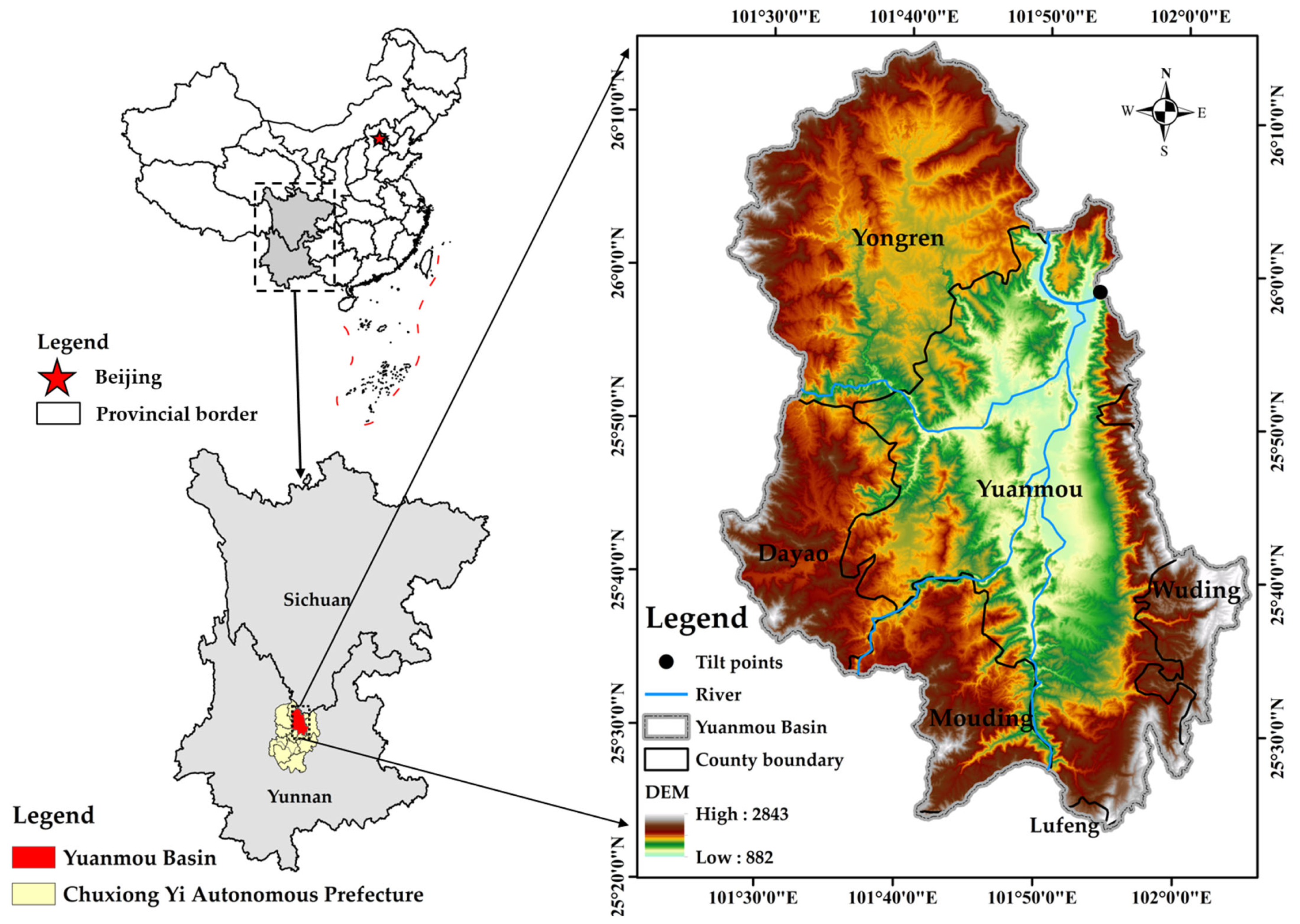
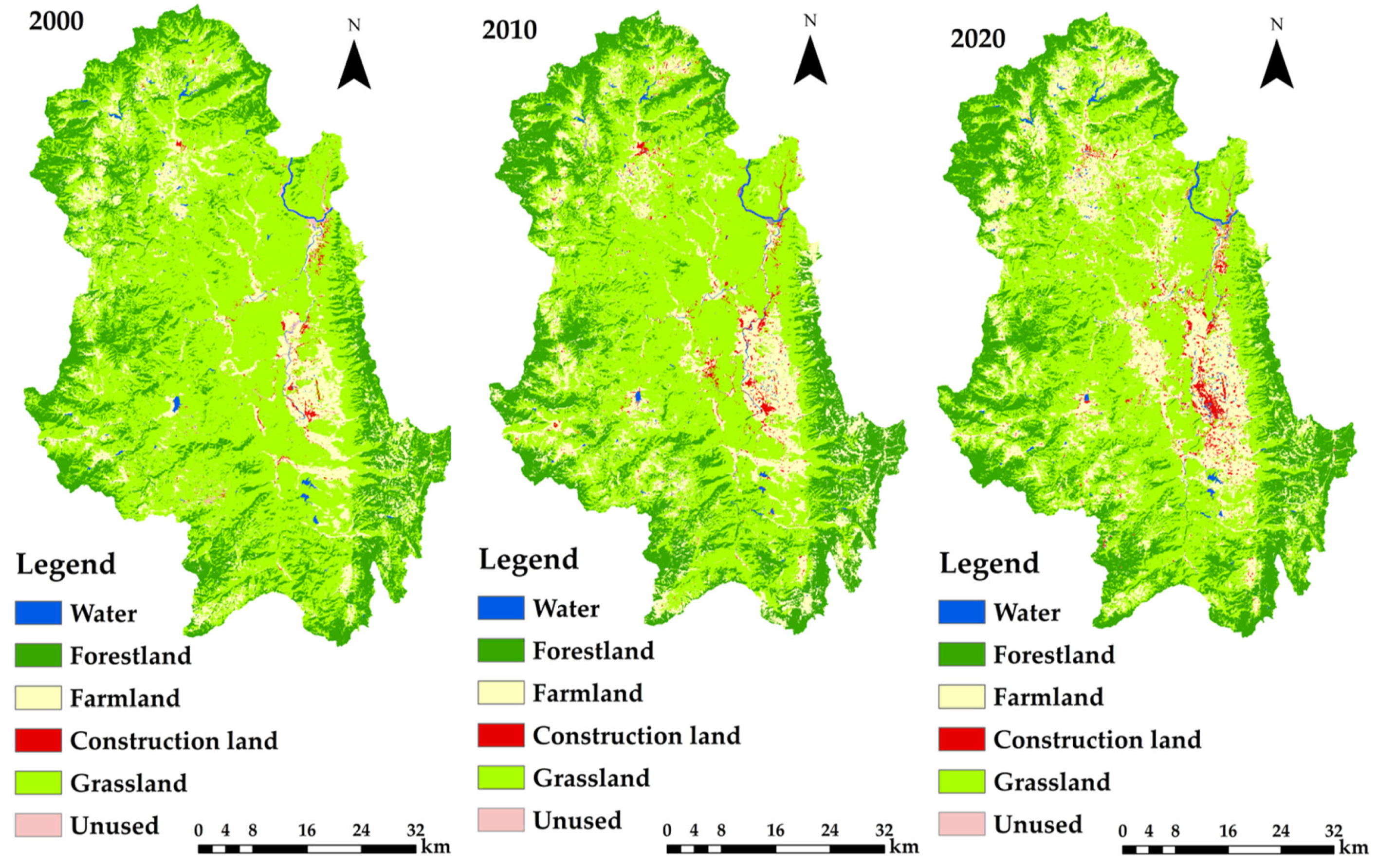
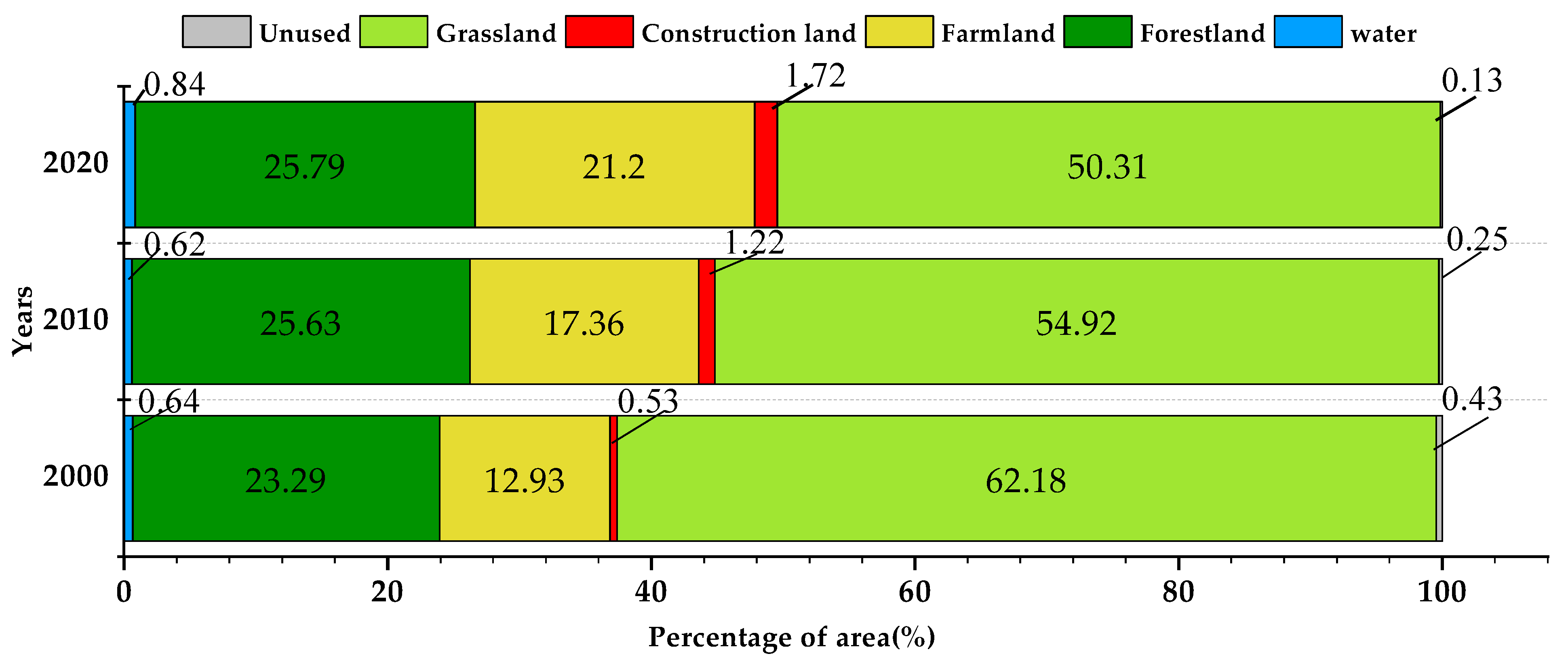
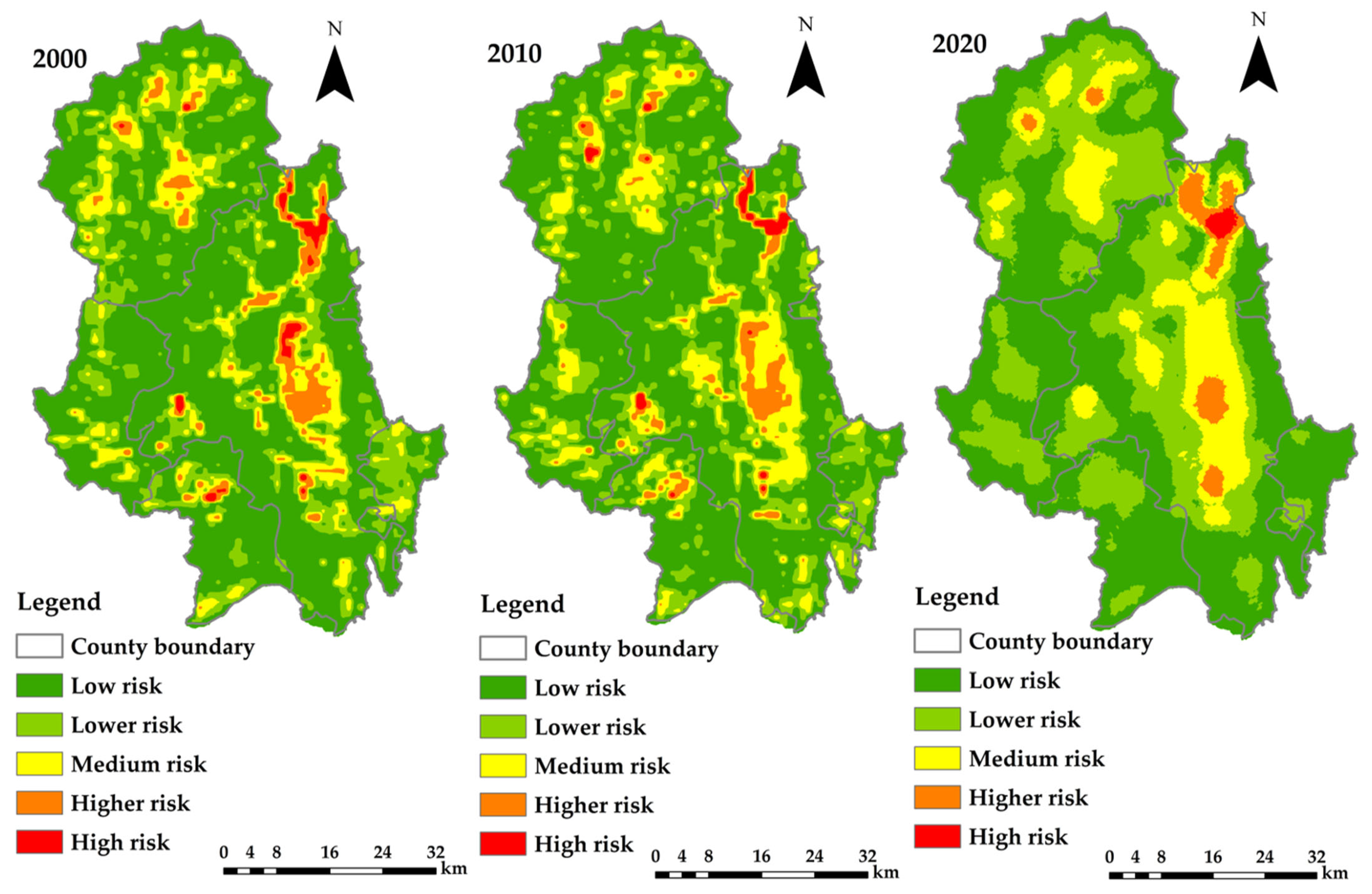
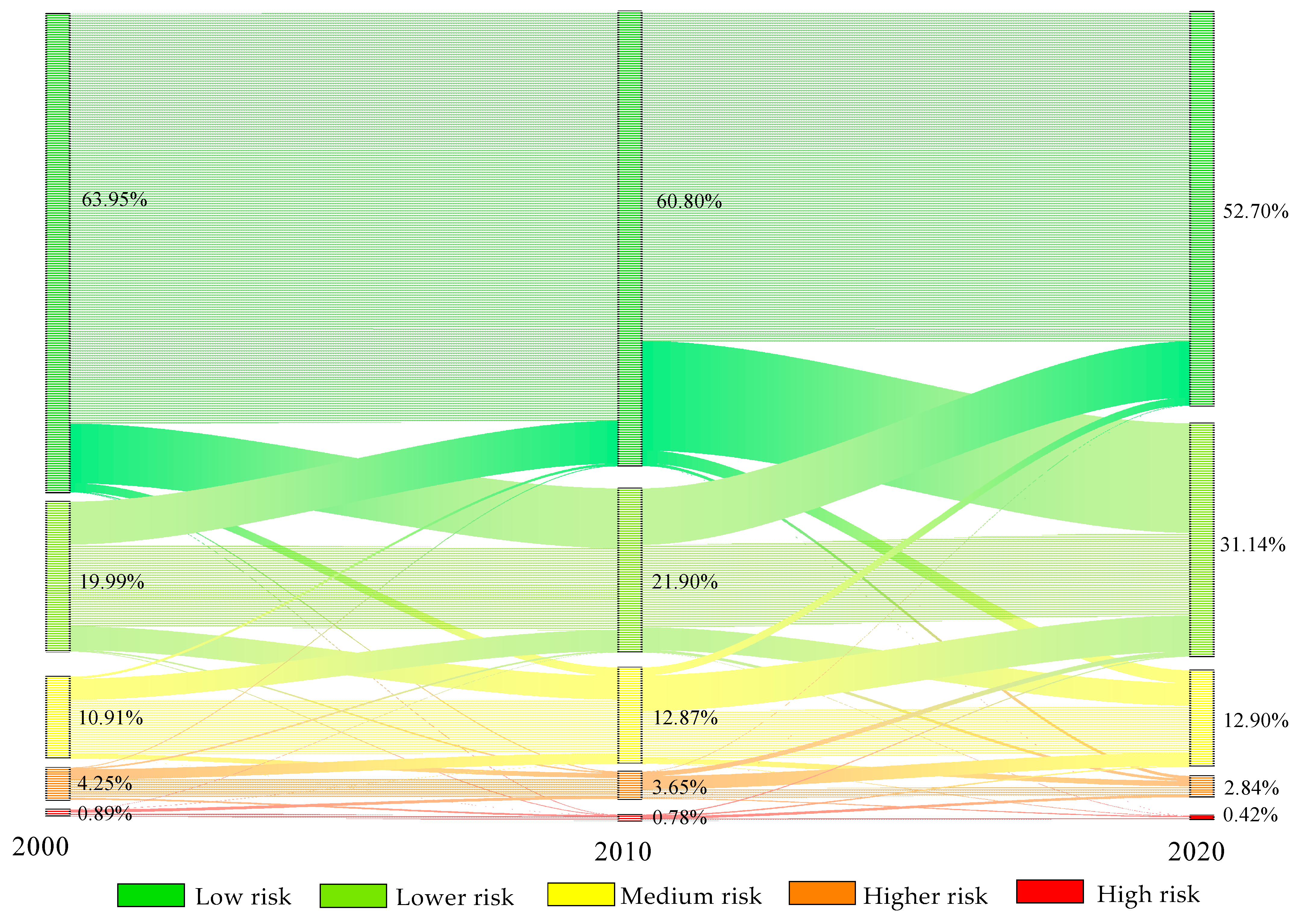
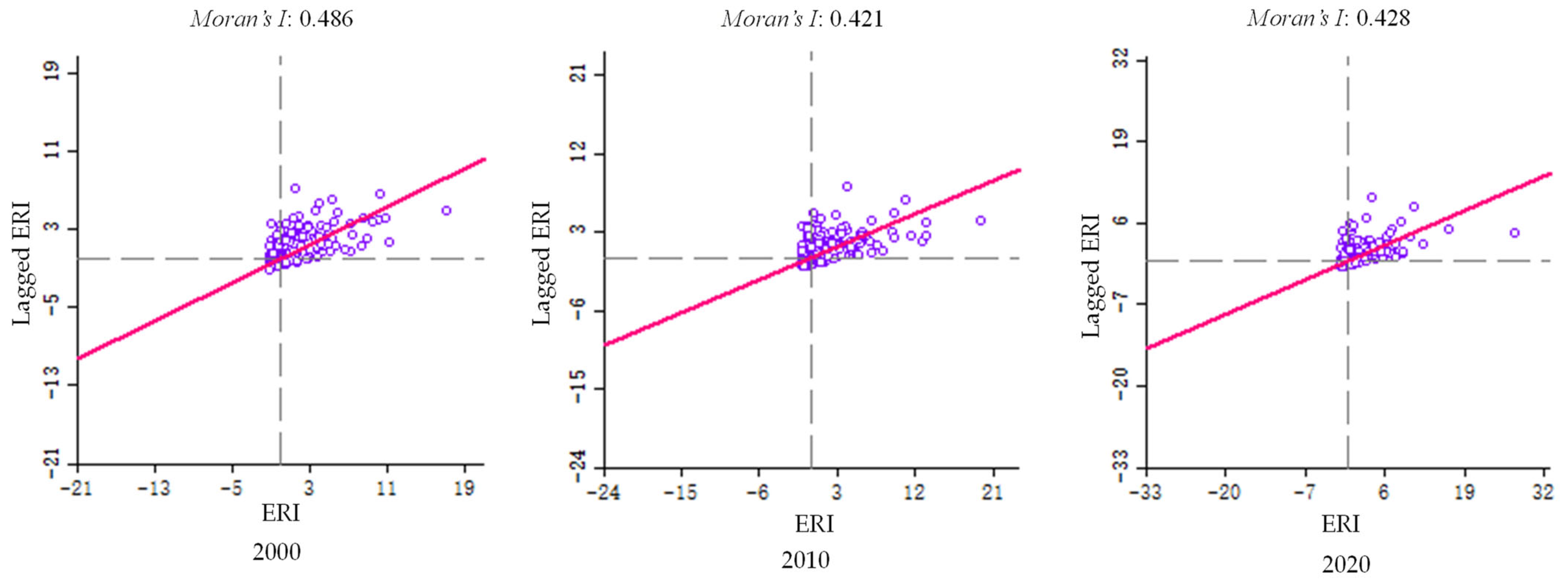
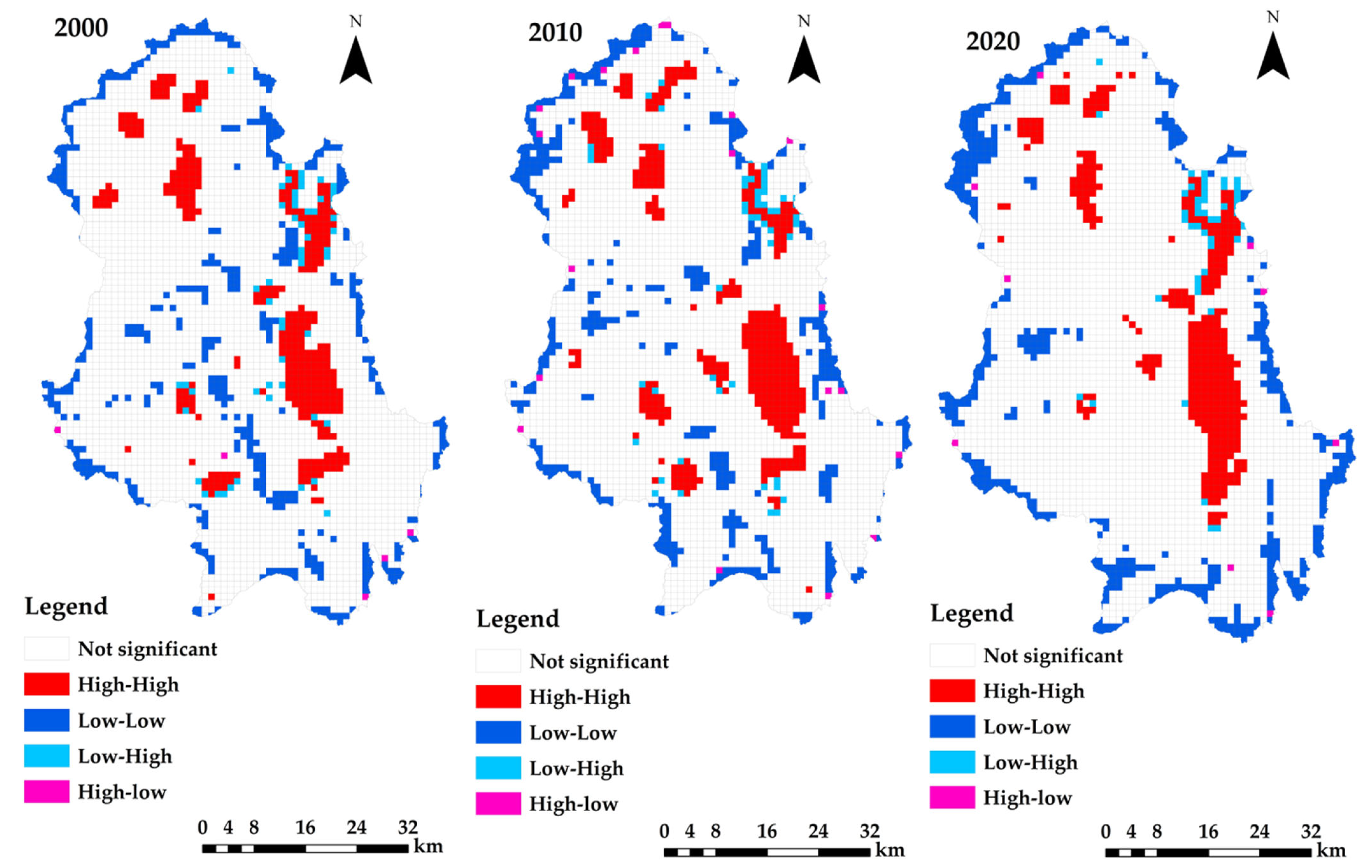


| Landscape Index | Calculation Formula | Notation Definition and Meaning |
|---|---|---|
| Landscape fragmentation index (Ci) | Ci is the landscape fragmentation index; ni is the number of patches in landscape i; Ai is the total area of landscape i (km2). Ci indicates the degree of fragmentation of the landscape. The larger the value, the less stable the ecosystem. | |
| Landscape Separateness Index (Fi) | FI is the landscape separation index; A is the total area of the landscape (km2); Ai is the total area of landscape i (km2); ni is the number of patches in landscape i. FI indicates the degree of separation between patches in landscape I. The larger the value, the more complex the spatial distribution of patches in that type of landscape. | |
| Landscape Dominance Index (Di) | Di is the landscape dominance index; Li is the ratio of the area of the i-th land use type to the total area of the study area; Mi is the ratio of the patch number in the i-th land use type to the total patch number. According to the expert scores, the weights α and β of Li and Mi are 0.6 and 0.4, respectively. The larger the Di value, the greater the influence of patches on the formation and change of landscape patterns, and the greater the corresponding ecological risk. | |
| Landscape Disturbance Index (Ui) | Ui is the landscape disturbance index; Ci is the landscape fragmentation index; Fi is the landscape separation index; Di is the landscape dominance index; a, b and c are the landscape fragmentation, separation and dominance weights, respectively. They are assigned as 0.5, 0.3 and 0.2, respectively. Ui indicates the degree of influence of human activities on the landscape pattern. The higher the value, the more significantly the ecosystem is affected by human activities and the less stable the landscape. | |
| Landscape Loss Index (Ri) | Ri is the landscape loss index; Ui is the i-th landscape disturbance index; Vi is the i-th landscape fragility index. |
| 2000 | Type of Land Use | 2020 | ||||||
| Water | Forestland | Farmland | Construction Land | Grassland | Unused Land | Total | ||
| water | 16.41 | 0.25 | 4.04 | 0.71 | 0.88 | 0.21 | 22.51 | |
| forestland | 0.95 | 660.38 | 17.65 | 0.20 | 139.11 | 0.04 | 818.34 | |
| farmland | 5.62 | 23.57 | 313.91 | 18.03 | 93.21 | 0.30 | 454.63 | |
| construction land | 0.34 | 0.02 | 6.44 | 8.84 | 2.49 | 0.32 | 18.46 | |
| grassland | 5.34 | 222.11 | 396.20 | 31.13 | 1529.61 | 0.93 | 2185.32 | |
| unused land | 0.89 | 0.02 | 6.86 | 1.64 | 2.95 | 2.93 | 15.28 | |
| Total | 29.55 | 906.35 | 745.10 | 60.56 | 1768.25 | 4.72 | - | |
| Zoning | Ecological Risk Zones | 2000 | 2010 | 2020 | |||
|---|---|---|---|---|---|---|---|
| Area (km2) | Percentage (%) | Area (km2) | Percentage (%) | Area (km2) | Percentage (%) | ||
| Dry-hot area | Low | 863.15 | 57.01 | 831.34 | 54.91 | 500.99 | 33.09 |
| Lower | 282.67 | 18.67 | 294.35 | 19.44 | 524.93 | 34.67 | |
| Medium | 215.51 | 14.23 | 263.54 | 17.41 | 380.19 | 25.11 | |
| Higher | 124.24 | 8.21 | 101.00 | 6.67 | 93.38 | 6.17 | |
| High | 28.35 | 1.87 | 23.70 | 1.57 | 14.46 | 0.96 | |
| Subtotal | 1514 | 100 | 1514 | 100 | 1514 | 100 | |
| Non-dry-hot area | Low | 1383.94 | 69.18 | 1304.98 | 65.23 | 1350.87 | 67.49 |
| Lower | 420.40 | 21.01 | 475.73 | 23.78 | 570.70 | 28.51 | |
| Medium | 168.21 | 8.41 | 188.93 | 9.44 | 73.55 | 3.67 | |
| Higher | 25.20 | 1.26 | 27.39 | 1.37 | 6.33 | 0.32 | |
| High | 2.87 | 0.14 | 3.61 | 0.18 | 0.00 | 0.00 | |
| Subtotal | 2001 | 100 | 2001 | 100 | 2001 | 100 | |
Disclaimer/Publisher’s Note: The statements, opinions and data contained in all publications are solely those of the individual author(s) and contributor(s) and not of MDPI and/or the editor(s). MDPI and/or the editor(s) disclaim responsibility for any injury to people or property resulting from any ideas, methods, instructions or products referred to in the content. |
© 2023 by the authors. Licensee MDPI, Basel, Switzerland. This article is an open access article distributed under the terms and conditions of the Creative Commons Attribution (CC BY) license (https://creativecommons.org/licenses/by/4.0/).
Share and Cite
Zhao, L.; Shi, Z.; He, G.; He, L.; Xi, W.; Jiang, Q. Land Use Change and Landscape Ecological Risk Assessment Based on Terrain Gradients in Yuanmou Basin. Land 2023, 12, 1759. https://doi.org/10.3390/land12091759
Zhao L, Shi Z, He G, He L, Xi W, Jiang Q. Land Use Change and Landscape Ecological Risk Assessment Based on Terrain Gradients in Yuanmou Basin. Land. 2023; 12(9):1759. https://doi.org/10.3390/land12091759
Chicago/Turabian StyleZhao, Lei, Zhengtao Shi, Guangxiong He, Li He, Wenfei Xi, and Qin Jiang. 2023. "Land Use Change and Landscape Ecological Risk Assessment Based on Terrain Gradients in Yuanmou Basin" Land 12, no. 9: 1759. https://doi.org/10.3390/land12091759
APA StyleZhao, L., Shi, Z., He, G., He, L., Xi, W., & Jiang, Q. (2023). Land Use Change and Landscape Ecological Risk Assessment Based on Terrain Gradients in Yuanmou Basin. Land, 12(9), 1759. https://doi.org/10.3390/land12091759








